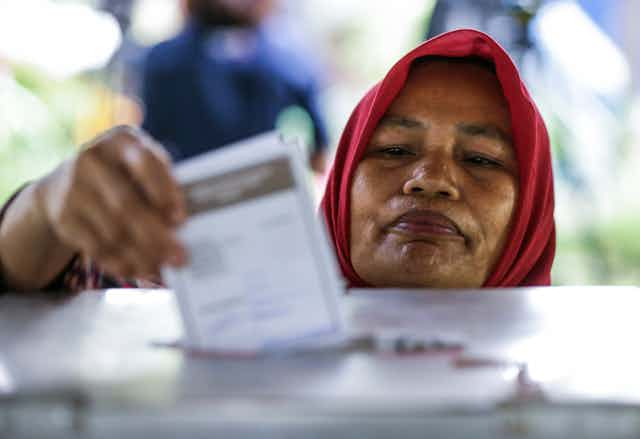This is the third article for this month’s theme on women to commemorate Kartini Day – celebrating Indonesian hero for female empowerment Raden Ajeng Kartini – which falls on April 21.
Indonesia is set to choose its local leaders through direct regional elections on June 27 2018.
Compared to previous regional elections in 2015 and 2017, the number of female candidates registered to run this year has increased. Two of them are strong contenders to become the first elected female governors in Indonesia.
For the first regional election in 2015, there were 123 female candidates out of a total of 1,646 candidates, or around 7.47%. In 2017, the figure dropped to 7.26%, or 45 of the 620 nominees in total.
This time the number of female candidates for regional local offices is 101 out of a total of 1,136, or around 8.89%.
Based on the rates of female candidates elected in the 2015 and 2017 regional elections, their chances of winning improved. In 2015, at least 28% of the female candidates won. The rate jumped to 31% in 2017 (Table 1). But will 2018 continue the pattern?

Power mapping
Due to the low percentage of female candidates in the country’s local elections, I will not measure their electability rates against male contenders. Instead, I will measure their chances of winning from other female candidates.
Let’s start by reviewing the power distribution of female candidates in the previous regional elections.
In 2015, 24 out of 57 female candidates won elections for regents and mayors. Twenty-one of them were elected as regents, while the remaining three became mayors. These winners accumulated 57.44% of votes on average.
The chances for women to win deputy positions at these elections stood at 33.33%, with victories for 22 of the total 66 female nominees. These winners secured 44% of votes on average.
Based on the above data, I argue that women have better chances of winning at the regency level. More than half of female candidates running for regents won the elections. Only one-third of female candidates won mayoralty positions (Table 2).
From various local government positions, women had bigger chances of being elected when they were running for regents (0.67) than for mayors (0.47), deputy regents (0.42) and deputy mayors (0.36).

Meanwhile, data from the 2017 elections showed that the turnout of female voters was higher than men’s, standing at 76.2%. Unfortunately, their votes did not all go to female candidates.
How about 2018?
For this year’s regional elections, 48.72% of female candidates are standing for deputy mayor positions, followed by those vying for mayor (41.02%) and governor (11.76%) positions.
Almost half (43%) of the female candidates are members of political parties. Most of these candidates are former legislators (39%) or related to local leaders and political leaders (39%).

The above patterns indicate that voting tends to favour candidates having either family ties or connections with local leaders, experience in the parliament or membership of political parties. These factors are crucial in helping women secure political nomination as local leaders.
Political kinship – as the wife or the daughter of the party elites or the current local leaders – is often perceived as a catalyst for securing public votes.
Having a status as a legislator also enables a candidate to establish an excellent connection with the voters.
In addition, membership of political parties helps female candidates to secure nomination, as most candidates (both males and females) are nominated through political parties under the current political system.
Such backgrounds, however, have raised some concerns.
With high-level political connections, it is unlikely a winning female candidate will bring any policy breakthrough that will prioritise the interests of women and marginalised groups.
This issue is evident in the lack of gender-related issues in the programs of female candidates in the 2018 regional elections. The latest study from the Association for Elections and Democracy (Perludem) showed that only 36.6% of female hopefuls inserted the word women, female or mothers in their vision, mission and programs. But, even once they include the words, no clear policies or strategies are available to overcome gender disparity.
Forecasting two governor hopefuls
Based on their backgrounds, I identify at least two strong female contenders in the upcoming regional elections.
The first one is former social affairs minister Khofifah Indar Parawansa, who will compete against incumbent Saifullah Yusuf in the East Java gubernatorial election. This is Khofifah’s third attempt at winning the governorship.
Khofifah is a strong contender due to her status as a prominent female political figure. Eight political parties supported her nomination.
Another strong candidate is Karolin Margret Natasa, who will compete with two male contenders in the West Kalimantan gubernatorial election.
Having won general elections in 2009 and 2014, Karolin is a former legislator in the House of Representatives. She became the regent of Landak in West Kalimantan last year after running as the sole candidate, securing a landslide 96.72% of votes.
Aside from her background as a member of parliament, Karolin is also the daughter of Cornelis, the governor of West Kalimantan from 2008 to 2018. Karolin is also supported by major political parties.
With their strong political background and connections, the two women have good chances to win the elections and become the first elected female governors in Indonesia.


